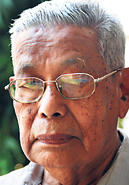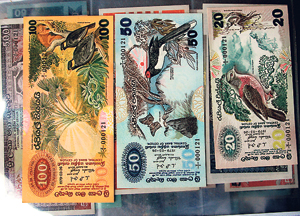An hour with T.M.U. Sallay will have you looking at those coins and notes in your wallet from a very different perspective. As one of the first employees of Sri Lanka’s Central Bank, Mr. Sallay will be the first to tell you that the money we use so casually can not only be a work of art, but also be a victim of politics. Its ebb and flow are tremendously complex, but for a man who delights in the details there is a story worth telling behind every new coin and every change in colour.
Mr. Sallay was not always a connoisseur of currency; he recalls, for he once sold some of his father’s collection for the price of the metal it was made off. However, when he was 30, he applied for a post at the then newly-formed Central Bank. He got the job in the Currency Department of the Central Bank of Ceylon (as it was then known) as a non-staffer in early 1951. He stayed with the bank for over three decades until his retirement as a Senior Assistant Superintendent.
“A graduate from the University of Experience,” Mr. Sallay continues to collect coins and notes today and has been known to drop in on a meeting of the Numismatic Society – of which he was a founder member. Though in his late 80s, his memory is sharp and in his head is a veritable treasure trove of stories...case in point – the incident of the purple five rupee note.
It’s the early 1950s and in the home of Deputy Governor Rajapatirana, a domestic given a five rupee note, returned with change for two rupees only. The D.G’s wife was upset, and the matter came to the notice of the Governor. The confusion was because both notes were of the same colour. In 1954, when a new run was commissioned, the colour of one of the notes was changed to red.
Other changes have had less to do with practicality and more to do with business. Laki Senanayake’s iconic 1979 currency notes are today considered valuable works of art. Mr. Sallay is inordinately fond of those designs, not only for their aesthetic value but for the detail the artist incorporated into each piece. And he should know, having been deeply involved with the actual printing of the notes. “I had a really hard time because we had to give all the names of those trees and plants and animals,” he recollects, adding that he spent many hours with a warden in the Forest Department getting the scientific names exactly right.
Mr. Sallay still has his handwritten lists, and he uses them to illustrate what he considers evidence of the artist’s genius – the three banded crimson carp on the two rupee note was Puntius Nigrofasciatus, and it is a Grey Hornbill (Tockus Gingalenses) that sits atop the velvet tamarind tree (Dialium Ovoideum) in the ten-rupee note. The devil of course, was in the spellings.
 |
| T.M.U. Sallay |
These various endemic flora and fauna featured on the notes were also grouped together in their native climate zones. “The 100-rupee note for instance featured the Seldina bird which is found at about 4,000 feet above sea level,” says Mr. Sallay, adding that the plants and insects that share the note are all from the same elevation. Hence, the notes reflect their inspiration in their colouring as well as in the order in which various animals and plants hailing from different altitudes are placed.
When the government decided to switch designs, it was not because the notes could be easily forged as the public was led to believe at that time, but because the printers had changed -- Bradbury Wilkinson and Co. had given way to Thomas De La Rue. The truth was that the notes were not easy to duplicate -- several security measures had been included. In an article he wrote for World Coin News in 1981, Mr. Sallay cited, as an example of this, the unique circular patterns created from Sri Lankan corals that were placed on the top and bottom of the notes.
He remembers his last assignment with particular fondness. A new coin was released to carry the image of Sri Lanka’s first President J.R Jayewardene. There was only one problem – the coins had to be ready in three weeks but the Royal Mint normally took four to six months to create a new coin. Mr. Sallay was sent to London to see the process through.
It was only after he reached London that his office informed him that the powers on high were somewhat displeased though that this coin was to be a humble 1 rupee coin. They had decided that aside from the standard run, they would have the Royal Mint in London create 25 to 30 commemorative coins in gold. To date, Mr. Sallay seems positively amazed that the entire thing went off without a hitch. When he flew back on January 31, 1978, he was carrying a case filled with perfect gold coins. These precious replicas were then given to the President-elect a few days later. Most of the coins were gifted to family members and highly placed cabinet members.
They are today valued as collectors’ items. Ironically, Mr. Sallay never received the gold coin that he was supposed to have been given in recognition of his work.
Today, he doesn’t follow the trends as closely as he used to, and does not consider himself a serious collector. His love of the subject, however, has made him a favourite with other collectors – they know they will always find a story worth hearing when they sit down with Mr. Sallay for a chat. |


